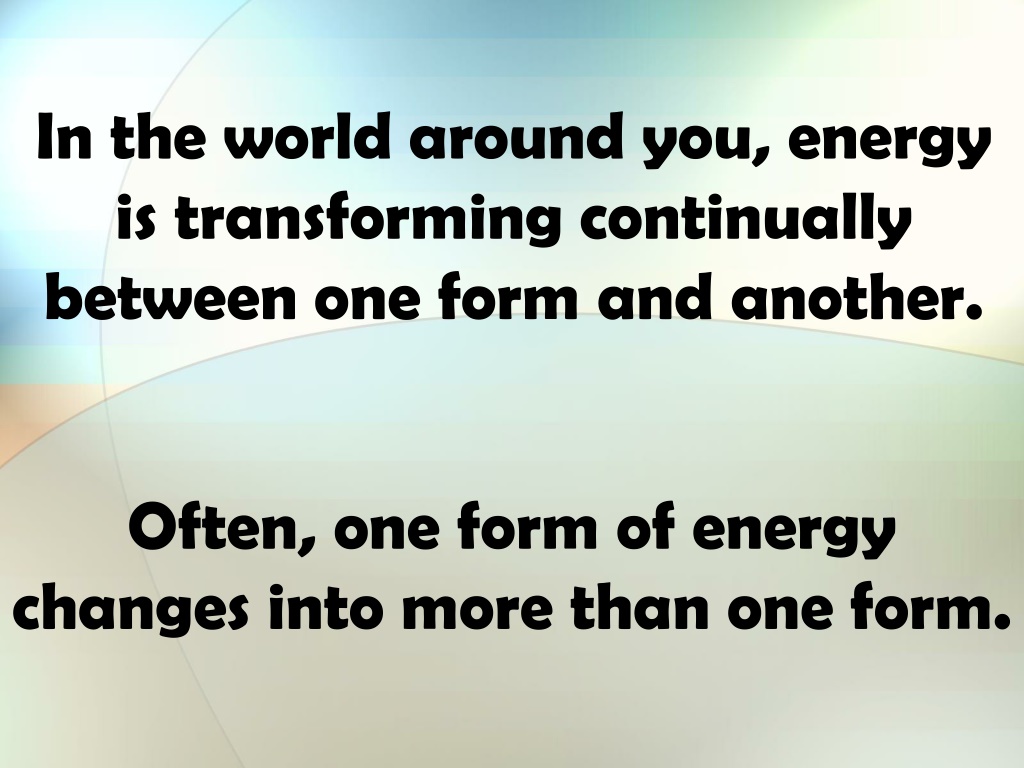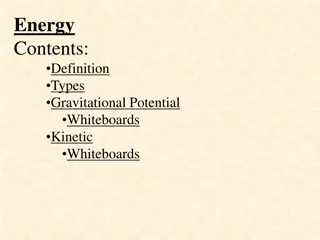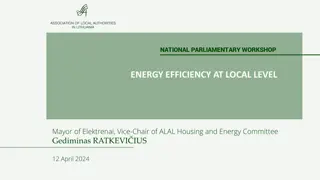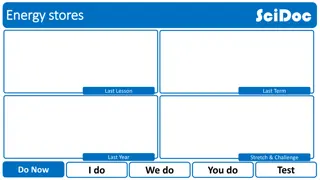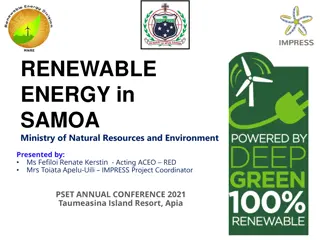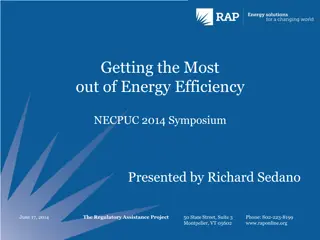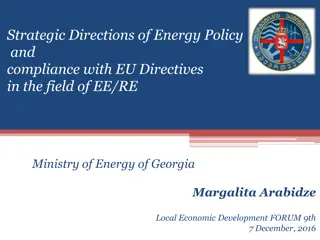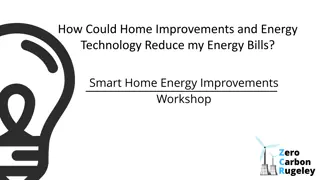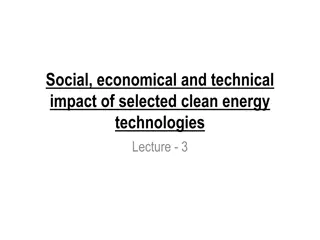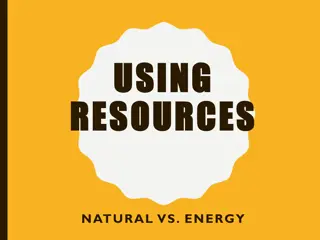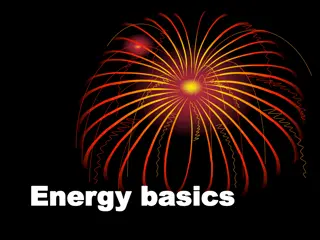Energy Transformation in the Natural World
Energy transformation occurs continuously in various forms around us, following the Law of Conservation of Energy. From thermal to chemical and electromagnetic energy, different types of energy are converted and utilized in everyday processes. Examples include the conversion of thermal energy to electromagnetic energy in sources like fire, the transformation of chemical energy in organisms into mechanical energy, and the utilization of radiant energy by plants for photosynthesis. These dynamic energy conversions emphasize the interconnectedness of energy forms in nature.
Download Presentation

Please find below an Image/Link to download the presentation.
The content on the website is provided AS IS for your information and personal use only. It may not be sold, licensed, or shared on other websites without obtaining consent from the author.If you encounter any issues during the download, it is possible that the publisher has removed the file from their server.
You are allowed to download the files provided on this website for personal or commercial use, subject to the condition that they are used lawfully. All files are the property of their respective owners.
The content on the website is provided AS IS for your information and personal use only. It may not be sold, licensed, or shared on other websites without obtaining consent from the author.
E N D
Presentation Transcript
In the world around you, energy is transforming continually between one form and another. Often, one form of energy changes into more than one form.
According to the Law of Conservation of Energy, energy is never created or destroyed, it just changes its form. Demonstration of the Law of Conservation of Energy: Exploratorium: Science of Baseball Baseketball a Physicist Party Trick
Law of Conservation of ENERGY In the world around you, energy is transforming continually between one form and another. Often one form of energy changes into more than one form. According to the Law of Conservation of Matter and Energy, Energy is never created nor destroyed, it just changes its form. KE + PE (beginning) = KE + PE (end)
Examples of Transforming Thermal (Heat) Energy When an object is heated to a high temperature, it glows and gives off heat. Therefore, some thermal energy is converted to electromagnetic energy Energy in the form of thermal (heat) is almost always one of the products of an energy transformation. A fire or a flame converts thermal energy to electromagnetic energy For example, when people exercise, when cars run, when a light is turned on, friction on anything moving, heat is produced.
Examples of Transforming Chemical Energy Inside your body, chemical energy is transformed into mechanical energy (kinetic energy) Batteries, wood, matches, fireworks, fossil fuels, etc. are forms of chemical energy that are converted into other forms once used or burned The matter contained in living organisms has chemical energy. When organisms die, this chemical energy is broken down and converted to other chemical compounds. In this process, thermal energy is released.
Examples of Transforming Electromagnetic (Light /Radiant) Energy Plants use light (radiant) energy to make chemical energy. [remember Photosynthesis] The chemical energy in food is then changed into another kind of chemical energy that your body can use. [remember cellular respiration] Your body then uses that energy to give you mechanical energy [kinetic and potential energy] Also, the electromagnetic (radiant) energy converted into chemical energy in say a tree can then be changed into thermal energy when you burn the tree s wood.
Examples of Transforming Electrical Energy Every time you plug something into a wall outlet, you are using electrical energy and that electrical energy is transformed into other forms of energy Blender: electrical energy mechanical energy and thermal Hairdryer: electrical energy mechanical energy, thermal energy Alarm Clock: electrical energy electromagnetic energy and mechanical (sound) energy
Lets examine the Energy Transformation in riding a bike. As the rider pedals, her leg muscles transform chemical energy (potential energy stored from the food she ate) into mechanical (kinetic) energy The mechanical (kinetic) energy of her leg muscles transforms into mechanical (kinetic energy) of the bicycle as she pedals Some of this energy transforms into potential energy as she moves up the hill Some energy is transformed into thermal energy (her body is warmer because chemical energy is released and because of friction, the mechanical parts of the bicycle are warmer too)
Energy Transformations in a Car A car engine transforms the chemical energy in gasoline into mechanical energy (kinetic and potential energy) Not all of the chemical energy is converted into mechanical energy. Some is converted into thermal energy, and the engine becomes hot. The chemical energy in the car battery is also transformed into other forms of energy
Identify other energy transformations that you can observe in a car.
Energy Transfer Mechanical (sound) Electromagnetic (light) Thermal Mechanical spnorm Electrical Chemical Electromagnetic (light)
Identify the energy transformations that occur when lighting a match. Lighting a match video clip (click on the picture below) In the video, chemical energy in the match changes to thermal (heat) energy and electromagnetic (light) energy. While the match is burning, is the amount of chemical energy in the match the same? Why or Why not? As the match is burning, the chemical energy is decreasing while the thermal energy and the radiant energy are increasing.
Study Jams Video: Energy and Matter http://studyjams.scholastic.co m/studyjams/jams/science/ma tter/energy-and-matter.htm
Lets see what you know about energy transformations. The following slides will show an image. Guess the type of energy transformation that occurs in the image.
Identify the Energy Transformation Electrical Mechanical (Sound)
Identify the Energy Transformation Nuclear Electromagnetic (Light) and Thermal Chemical
Identify the Energy Transformation Chemical Mechanical Thermal
Identify the Energy Transformation Electrical Thermal (Heat)
Identify the Energy Transformation Chemical Mechanical Thermal
Identify the Energy Transformation Electrical Mechanical and Thermal (Heat)
Identify the Energy Transformation Mechanical Thermal (Heat)
Identify the Energy Transformation Electrical Electromagnetic and Thermal
Identify the Energy Transformation Chemical Electromagnetic and Thermal
Identify the Energy Transformation Electromagnetic Electrical and Thermal
Identify the Energy Transformation Mechanical (Sound) Electrical Mechanical (Sound)
Identify energy transformations in the illustration below. Include the following: Thermal, Electromagnetic, Mechanical, Electrical, & Chemical
